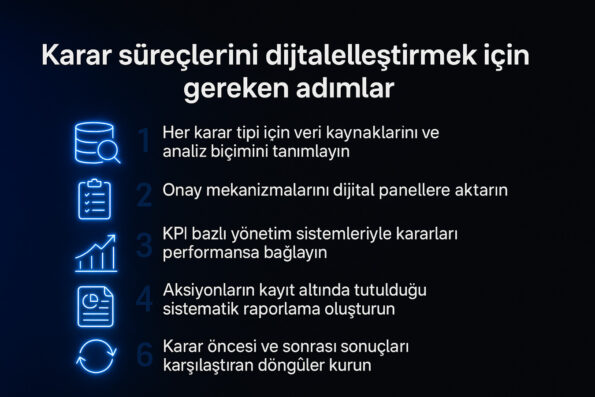When it comes to digital transformation, the first thing that comes to mind for most managers is software, automation, artificial intelligence, CRM systems or cloud-based infrastructures. However, this approach is only understanding the outer shell of digital transformation.
In reality, digital transformation is the process of changing the way an organization makes decisions. Technology may be the tool of this process, but it is not the essence.
Buying software, installing an ERP system or creating a data visualization dashboard does not make you digital. Digital transformation redefines institutional behavior patterns, methods of accessing and evaluating information, and processes of taking responsibility and sharing.
In other words, no matter how powerful the technology is, if decisions are still made with old reflexes, the transformation is just a make-up.
In this article, we will reveal that digital transformation is not only a technological change; it is also a cultural, managerial and strategic change. We will explain with concrete examples that institutions need to change their mindsets, not just their systems, and determine the points where transformation begins and succeeds.

İçindekiler
ToggleTechnology Is Not Enough: The Real Power of Transformation Lies in Decision Processes
Technology is an accelerator. It makes work easier, automates repetitive tasks, and makes communication instantaneous. However, without changing internal reflexes, these tools cannot provide sustainable development.
The real transformation is about how information is accessed, how it is analyzed, and how decisions are made based on this information.
Today, many institutions, despite having digital tools, still proceed in the cycle of “making decisions with feelings.” However, digital transformation builds a culture of thinking with data, not intuition. Decisions should be made with facts, not guesswork; actions should be planned with analysis, not assumptions.
Institutions That Do Not Make Data-Based Decisions Cannot Truly Transform
The foundation of digital transformation is the ability to think with data.
Unfortunately, many institutions see data only as something that “should be reported.” However, data is not just information; is a tool that shows direction.
Digitalized institutions act with metrics, not intuition.
Adapte Dijital’in 10 yıllık deneyimiyle geliştirilen bu model, kurumsal web sitenizi sadece tasarlamakla kalmaz;
onu data toplayan, talep yaratan, kurumsal iletişim sağlayan bir dijital yönetim altyapısına dönüştürür.
Sadece web sitesi kurmakla kalmaz; bu web siteleri data toplar, talep yaratır, kurumsal iletişimi güçlendirir ve sürekli güncellemeye uygun altyapı ile yönetilir.
Consequences of lack of data-based management:
- Decisions are based on personal experiences or assumptions
- Wrong decisions are repeated because no measurement is made
- Actions are unplanned and random
- Performance evaluations remain subjective
- Improvement areas are not recognized because no data is used
Managers Change Roles: From Controller to Data Guide
In traditional management, authority comes from having knowledge. However, with digital transformation, information becomes widespread and transparent.
The modern manager is not the one who controls information, but the one who directs it.
In other words, the task of managers is no longer to tell “how to work”, but to show “how to use data”.
Changing roles of managers in decision-making processes:
- The distribution of authority increases; decisions are made distributed, not centralized
- Teams can access data and analyze it themselves
- Managers manage results, not processes, through KPIs
- Feedback culture increases; horizontal information flow is established instead of vertical hierarchy
- Leadership becomes the role of drawing vision and interpreting data
Culture Change is a Must for Digital Transformation
No software can change corporate culture alone.
For digital transformation to be successful, corporate culture must first be reshaped around data, transparency, feedback and continuous development.
All technology investments made without this cultural infrastructure will soon become inactive.
The effects of cultural transformation on the digital process:
- Employees adapt to new technologies faster
- Transparency turns into digital reporting and open performance
- Development areas are not hidden, solution-oriented approach increases together
- Information sharing between teams accelerates
- Digital solutions become a natural part of daily operations
Transformation Does Not Start Without Digitalization of the Decision-Making Process
How are decisions made in an institution? is it taken?
Is a single person approving, or is it guided by data?
If decision-making processes are still manual, personal and instinctive, that institution is not considered digitalized, no matter how much software it uses.
The place where digital transformation begins is when decisions are digitalized.
Steps required to digitize decision processes:
- Define data sources and analysis format for each decision type
- Transfer approval mechanisms to digital panels
- Link decisions to performance with KPI-based management systems
- Create systematic reporting where actions are recorded
- Establish loops that compare pre- and post-decision results
How to Set Up a Digital Decision-Making Model?
Decision-making is an essential part of every organization’s daily operations.
However, in most institutions, this process is based on instinctive decisions made in meeting rooms, unwritten ideas and choices based solely on experience. Digital transformation completely changes this process.
The digital decision-making model highlights information, supports intuition and puts the institution into a measurable development cycle.
Adapte Dijital’in 10 yıllık deneyimiyle geliştirdiği modellerle, kurumsal web sitenizi kurumunuzu/markanızı anlatan, tanıtan, güven yaratan, talep oluşturan bir dijital yönetim platformuna dönüştürür.
Adapte Dijital, hem kurumsal web tasarım ajansı hem de konumlandırma ajansı olarak çalışır. Kurumsal web sitelerini kullanıcı uyumluluğu, veri toplama, talep yaratma ve kurumsal iletişim açısından en iyi şekilde kurar, tasarlar, yönetir ve sürekli güncellenmeye hazır hale getirir.
The purpose of this model is not only to make more accurate decisions. It is also to systematize how these decisions are made, who says what based on what, and to add them to the institutional memory. In the four headings below, you will see clearly how to set up this model.
5 Basic Steps of Digital Setup: Institutions Growing with Web Management We recommend that you read our article.
Management Infrastructure with Strategic KPIs
The first condition of the digital decision-making model: the definition of measurable performance indicators.
KPI (Key Performance Indicator) is not just numerical data. It is also the answer to the question “how will success be defined?” in the decision-making process.
An institution develops what it measures. What it does not measure is neglected over time.
These KPIs should be created not only on a general basis, but also on a departmental basis, and even on an individual basis; all teams should work according to these indicators and managers should make their decisions according to these results.
What to do for strategic KPI definition:
- Determine 3 main, 3 support KPIs for each department
- Plan KPIs on a monthly, quarterly and annual basis
- Make them visible to all managers with visualization panels
- Monitor progress with retrospective comparisons
- Conduct decision-making meetings based on KPI data >
Decision Panels and Automation Triggers
Boards or department leaders should not have to search for Excel to see data.
Within the digital decision model, decision panels should be created for each unit, and these panels should be updated at certain thresholds should be supported by automations that trigger decision-making.
In other words, the system does not only display, but also warns and prompts.
In this way, for example; “when 70% of a campaign budget is used,” or “when a form conversion rate falls below 15,” the system sends automatic notifications to administrators. In this way, decisions are made proactively, not reactively.
The structure that should be created for decision panels:
- Create dashboards that show all KPIs visually and in real time
- Set up automatic alert systems for each threshold value
- Integrate with platforms such as CRM, email, Slack
- Make panels filterable by authority level
- For critical decisions Add archiving that can follow the “event-development-decision” chain
Team-Based Authorization and Data Sharing
Digitalization is not just about producing data; data must be shared transparently.
If teams cannot access data, they cannot reach insight. Without insight, decisions are still made by instinct.
Therefore, a team-based authorization structure should be established so that each team can have full access to data related to their own field, and development data should be shared on common panels.
Thus, all decisions can be made not only by senior management, but also by middle and operational teams. This increases organizational agility.
Steps for team-based data management:
- Create custom reporting dashboards for each team
- Provide access only to relevant data with authorization rules
- Define intra-team feedback forms and panels
- Create weekly “data sharing sessions” for data sharing
- Open up spaces for ideas and data interpretation in a shared decision-making platform

Improving Decisions with a Feedback Loop
The decision-making model for digital transformation does not work one-way.
After making a decision, the effects of this decision should be observed, data should be analyzed, and new decisions should be shaped with these outputs.
This cycle feedback model and is the most critical mechanism for the sustainability of digitalization.
Feedback shows not only mistakes but also opportunities. Which decision worked, which offered room for improvement, which action received positive feedback? Following these will help you avoid repeating the same mistakes and reproduce the same successes.
Things to set up for a feedback system:
- Define a monitoring period for each decision taken (e.g. 30 days)
- Observe how KPIs change during this period
- Send performance reports to the relevant team and ask for comments
- Add successful decisions to internal process guides
- Re-evaluate decisions that can be improved
5 Critical Institutional Gains of Strengthening Decision-Making Processes with Digital Transformation
Digitalization of decision-making processes enables the organization to work not only “faster” but also “more accurately, more inclusively and more efficiently”.
This transformation; is not just a technological development, but a cultural, structural and operational change that encompasses all units of the organization.
Thanks to data-supported decisions, errors are reduced, resource use is more effective and employee loyalty increases.
The digital decision-making model puts organizations ahead of the competition. Managers no longer make decisions based on intuition, but rather evidence-based decisions. This affects not only internal processes, but also external relations, reputation management and financial results. Let’s clearly examine how this transformation provides permanent contributions to the institution in the following headings.
How Does Corporate Website Investment Turn Into a Revenue-Generating System? We recommend that you read our article.
1. Increased Operational Efficiency
Basing decision processes on data and automation reduces manual workload and eliminates operational bottlenecks.
Teams hold fewer meetings, ask fewer questions, and wait less.
Because everyone can access the information they need and track their responsibilities through the system.
Gains for increased operational efficiency:
- Routine decisions are made automatically or suggested by the system
- Approval processes are accelerated, waiting times are shortened
- Unauthorized interventions are reduced, responsibilities are clarified
- Daily reporting is automated
- Rapid responses can be given in times of crisis because the information is already ready
2. Management in Line with Strategic Goals
Digital decision systems affect not only the current operations of the institution but also future planning.
Thanks to KPI-based structures, all decisions become aligned with predetermined strategic goals.
Thus, every step is taken as a contribution to the institution’s vision.
Benefits provided for strategic alignment:
- Every decision is aligned with the strategy; aimless steps are reduced
- Off-target activities are detected at an early stage
- Budget planning is optimized based on data
- Project prioritization is made according to KPI performances
- The entire organization is focused on common goals
3. Increased Employee Engagement and Team Participation
Data-driven systems allow employees to see their own performance and understand their areas of development.
In addition, being able to see the same data set as managers allows employees to feel more equal and more involved.
This returns to the organization as commitment, ownership and proactive behavior.
Effects that increase team engagement:
- Uncertainty is reduced as performance goals become clear
- Employees are recognized as they contribute data to the process
- Individual achievements become visible through the system
- Feedback is more constructive as it is based on concrete data
- Teams set development goals together, shift from competition to collaboration can be passed
4. Reputation and Institutional Trust Increase
Digital decision systems increase the external reliability of the institution.
Because decisions are based on data, processes are based on transparency, and communication is based on accountability.
Both customers, business partners, and public authorities perceive this systematic structure as seriousness, predictability, and quality.
We recommend you to read our article on corporate web design agency.
Contributions that increase corporate trust:
- Transparent reports can be presented to stakeholders
- Errors are quickly corrected because they are analyzed with data
- Strategic steps are convincing because they are justified with data becomes
- Consistency in processes increases, external perception becomes professional
- Corporate communication becomes fast and clear because it is fed by digital systems
Conclusion: Digitalization is a Transformation of Mindset, Not Technology
As a result; For digital transformation to be permanent and efficient, simply installing software or using tools is not enough.
The real transformation begins with changing how decisions are made. You can also visit the Digital Transformation Office website.
The digital decision-making model allows not only managers but also the entire team to think, measure and develop based on data.
You should also read our article on digital transformation consultancy.
When decisions are digitalized; processes accelerate, errors decrease, efficiency increases and the institution becomes a learning organism with all its parts.
Transformation occurs not only with tools, but how these tools are used.
And the most permanent transformation is the digitalization of the mindset.
- Uncertainty is reduced as performance goals become clear
- Employees are recognized as they contribute data to the process
- Individual achievements become visible through the system
- Feedback is more constructive as it is based on concrete data
- Teams set development goals together, shift from competition to collaboration can be passed
4. Reputation and Institutional Trust Increase
Digital decision systems increase the external reliability of the institution.
Because decisions are based on data, processes are based on transparency, and communication is based on accountability.
Both customers, business partners, and public authorities perceive this systematic structure as seriousness, predictability, and quality.
We recommend you to read our article on corporate web design agency.
Contributions that increase corporate trust:
- Transparent reports can be presented to stakeholders
- Errors are quickly corrected because they are analyzed with data
- Strategic steps are convincing because they are justified with data becomes
- Consistency in processes increases, external perception becomes professional
- Corporate communication becomes fast and clear because it is fed by digital systems
Conclusion: Digitalization is a Transformation of Mindset, Not Technology
As a result; For digital transformation to be permanent and efficient, simply installing software or using tools is not enough.
The real transformation begins with changing how decisions are made. You can also visit the Digital Transformation Office website.
The digital decision-making model allows not only managers but also the entire team to think, measure and develop based on data.
You should also read our article on digital transformation consultancy.
When decisions are digitalized; processes accelerate, errors decrease, efficiency increases and the institution becomes a learning organism with all its parts.
Transformation occurs not only with tools, but how these tools are used.
And the most permanent transformation is the digitalization of the mindset.






